How to Play Spider Solitaire
By Neal Taparia - 03/14/2024
Spider Solitaire is a one-player game of skill and patience. You play with two decks of cards dealt into ten columns and the stockpile. To learn the game, you can start with Spider Solitaire One Suit, which is the easiest. Once you get comfortable with Spider Solitaire rules, you can play more difficult Two Suit and Four Suit variations.
This post explains how to play Spider Solitaire and the best strategies to help you win.The Objective of Spider Solitaire
To win Spider Solitaire, you have to clear the board by arranging stacks of cards of the same suit in descending order, from king to ace. Once you’ve built a set, you move it to the foundation pile. It differs from Klondike Solitaire in that you order the cards before you put them in the foundation piles and there are twice as many cards, which means you use two standard decks with eight foundation piles instead of one deck with four foundation piles.
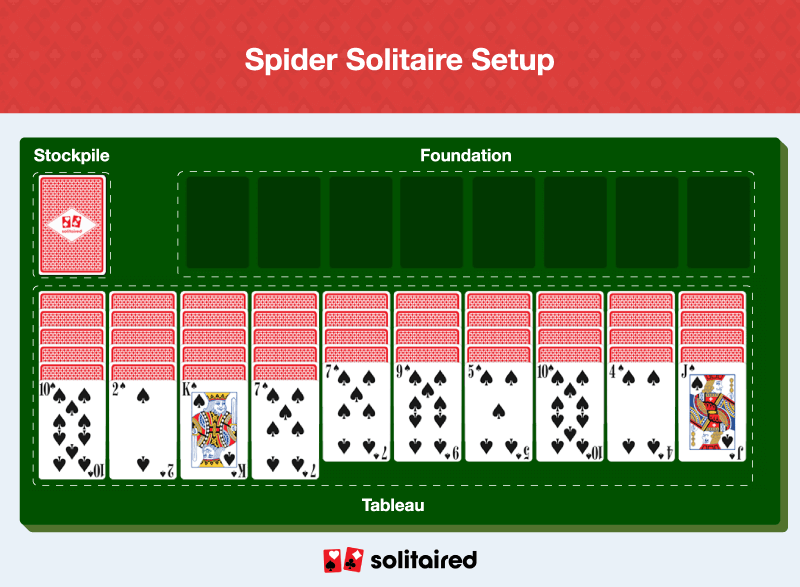
Spider Solitaire Setup
Here is how you should set up Spider Solitaire:
- Tableau: You deal cards onto the tableau. The tableau piles include ten columns. The first four columns will have six cards each, and the next six columns will have five cards each. The last card in each column is flipped face up.
- Stockpile: Place the remaining cards facedown in a stockpile. These cards can be used when you run out of moves. Just place ten cards face up at the bottom of each column, slightly overlapping each of the face-up cards already in the tableau.
- Foundation piles: You use eight foundation piles to move your completed sequences, from king to ace, for each suit. Once you’ve completed all eight piles, you win.
How to Play Spider Solitaire
This section explains how to play one-suit Spider Solitaire, which is the easiest version to play. There’s one-suit, two-suit, or four-suit, and they get progressively more difficult as you add suits. With one suit, you only focus on the numbers, not the colors or other suits.
Build Descending Sequences of the Same Suit
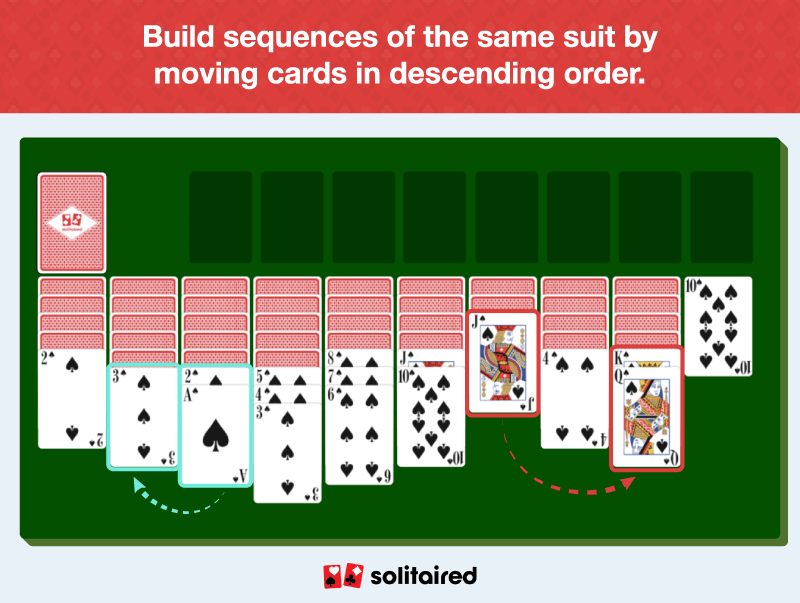
The object of the game is to build descending sequences of the same suit in the tableau and then place the completed sequences in the foundation piles. You can move face-up cards in the tableau onto another card that is one rank higher. Then you move groups of cards that are sequenced completely in the same suit to the foundation pile.
You can move sequences on top of a single card as long as the first card in the sequence you’re moving is one rank lower than the card you’re placing the sequence on. For example, if you have a sequence that includes the queen of spades, jack of spades, and the ten of spades, you can move the entire sequence on top of the king of spades.
Reveal Uncovered Facedown Cards
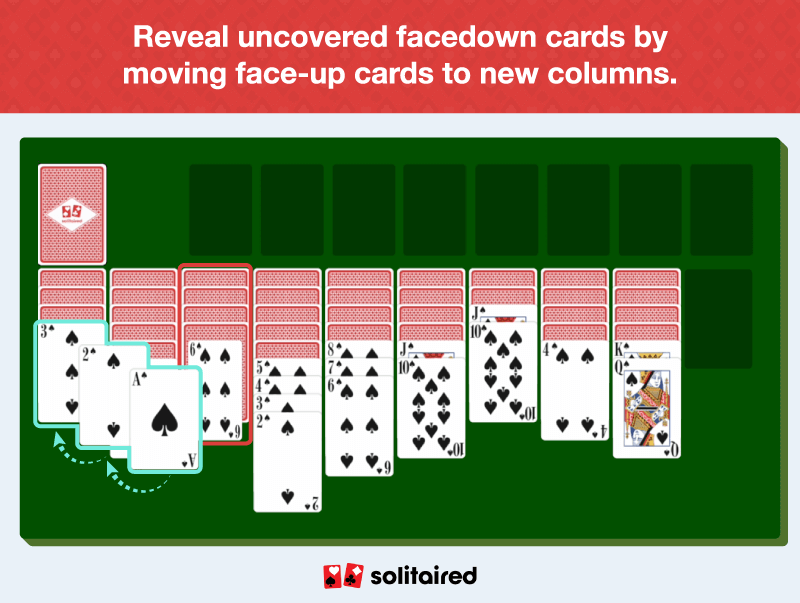
As you move the face-up cards to a new sequenced column or foundation pile, you reveal the facedown card below, which you can use as the next card in your gameplay. Revealing facedown cards helps you make more moves.
If You Run Out of Moves, Draw From the Stockpile
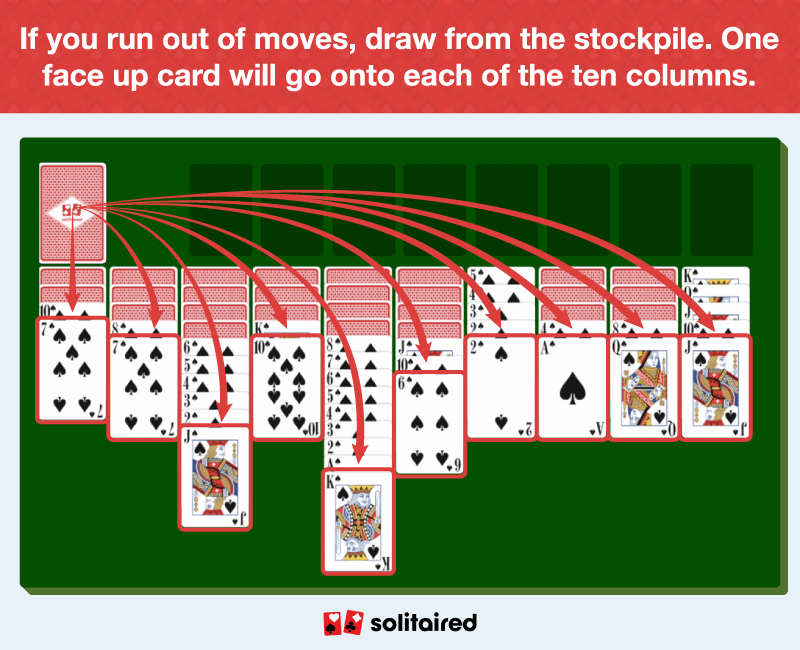
If you ever become stuck, you can draw from the stockpile. You can only draw from the stockpile if there’s at least one card in each of the ten columns on the tableau. When you draw from the stockpile, you get ten new cards that are placed on the faceup cards. Ten cards for the ten columns give you fresh cards to expand your play when you’re stuck.
Move Cards to Empty Columns
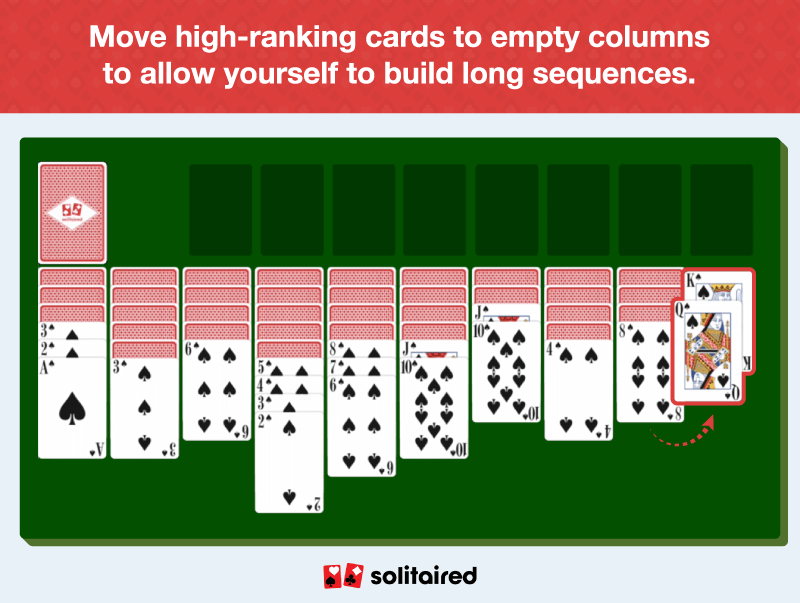
As you move the cards, you will eventually empty a column. Once the space is vacated, you can move any card or sequence of cards into the empty space. You can only move a group of cards if they are sequenced or in the same suit, although suit doesn’t matter for one-suit Spider Solitaire. You may want to move high-ranking cards into the empty column to allow you to build long sequences.
Form Eight Sequences to Win

After you complete sequences, they are placed in the foundation piles. That is the goal of the game, and once you get all eight sequences into the foundation pile, you win.
Spider Solitaire Strategies
Now that you know how to play the game of Spider Solitaire, here are some strategies to help increase your chances of winning.
Prioritize Moves That Will Expose Facedown Cards
The more faceup cards you have, the more moves you can make, which keeps the cards moving and keeps you in the game. If you are playing two-suit or four-suit variations, you may need to play cards on top of others that aren’t of the same suit to free facedown cards. Try to use this sparingly and only to unlock more moves.
Move Higher Cards to Empty Columns
Once you have empty spaces on the board, try moving higher cards to those spots to give you space to work downward and get rid of more cards. Higher cards give you more opportunities to stack in that column. For example, if you move a four, you will only have three more cards that can be moved to that column. If you move a ten, you can move up to nine cards, from a nine down to an ace.
Make All Possible Moves Before Drawing from the Stockpile
Analyze every move you can make before you draw from the stockpile because drawing from the stockpile adds another card to the bottom of each of the columns. If you run out of stockpile cards and have no more moves, you lose the game.
Utilize the Undo Button
If you consistently get stuck or realize you’re blocking other cards, you can use the undo button to help correct yourself and make better moves. This will also help you plan better and learn how to make the best moves.
Spider Solitaire Variations
The more suits you add to Spider Solitaire, the harder the game gets. Here are some of the other variations you can play.
Two-Suit
In this version of Spider Solitaire, you can place any card on top of a card that is one rank higher, no matter the suit. For example, a three of hearts can be placed on a four of spades. However, only sequences of the same suit can be moved together.
In this case, the four of spades and three of hearts could not be moved to a five. However, a four of spades and three of spades could be moved as a set because they are the same suit.
Only completed sequences in a single suit can be moved to the foundation pile. Your goal is to make eight foundation piles with four of each suit.
Four-Suit
Just as with two-suit Spider Solitaire, in four-suit Spider Solitaire only single-suit stacks can be moved in a sequence or moved to the foundation pile.
For instance, if you move a three of diamonds onto a four of hearts, the four of hearts is blocked and cannot be moved together as a group until you move the three of diamonds and place a three of hearts in its place. This makes four-suit Spider Solitaire the hardest, as more suits make it harder for you to move same-suit cards around to win.
The Benefits of Playing Spider Solitaire
If you’re a beginner, starting with one-suit Spider Solitaire is the best as it is the most winnable. Two-suit Spider Solitaire has a win rate of 16.6% and four-suit Spider Solitaire has a win rate of 6.2%.
Here are the benefits of playing Spider Solitaire:
- Improves your memory. Sharpening your brain and using your memory consistently by playing Spider Solitaire will allow you to practice your memory skills, which you use in everyday life.
- Helps you unwind. Playing a game, especially winning one, releases endorphins and helps you relax. Play Spider Solitaire as you begin your bedtime routine or when you have a pocket of time.
- Enhances your problem-solving skills. Spider Solitaire forces you to utilize your critical thinking skills, which can be applied to the rest of your life outside the game.
- Teaches you patience. With Spider Solitaire, you cannot expect to win immediately. You have to think and work your way through each problem the game presents you with, so you have to be patient and trust the process.
Ready to Play Spider Solitaire?
If you’re looking to get hooked on a new card game in your life, try Spider Solitaire online at Solitaired. You can play as many games as you like to practice without having to download or register. Once you get better, you can log in and save your score to see how you stack up against other players. You can even share with friends, inviting them to play Solitaire and compare scores. If Spider Solitaire isn’t your jam, start off with Classic Solitaire or other online card games.
About the author

